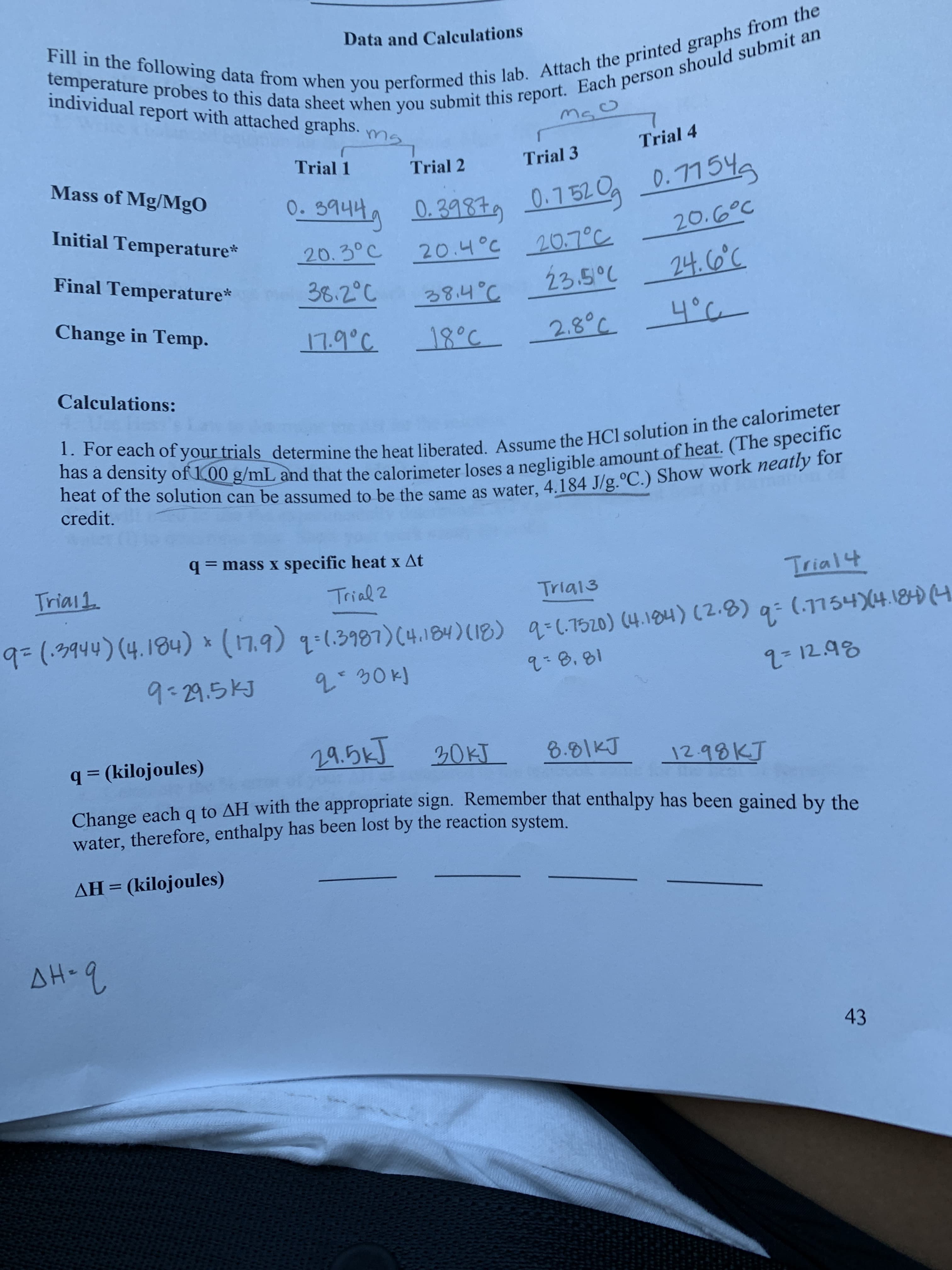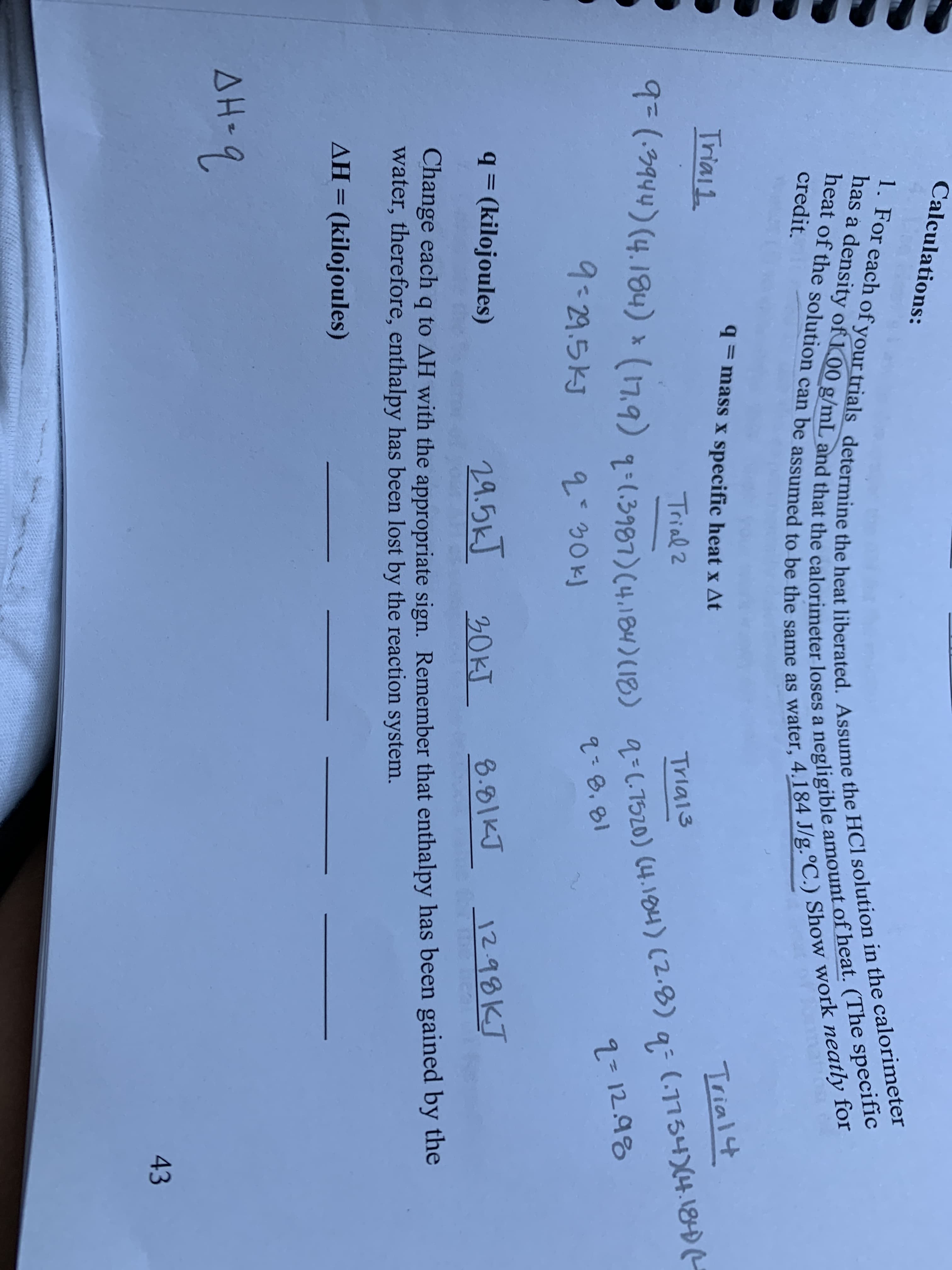Data and Calculations Fill in the following data from when you performed this lab. Attach the printed graphs from the temperature probes to this data sheet when you submit this report. Each person should submit an individual report with attached graphs. Trial 4 Trial 1 Trial 3 Trial 2 Mass of Mg/MgO 0.344 0.398 0.1520 D.115 Initial Temperature* 20.6°c 20.4°c 20.7°C 23.5°C 20. 3°C Final Temperature* 24. 0c 36.2°C Change in Temp. 2.80c _18°८ । Calculations: 1. For each of your trials determine the heat liberated. Assume the HCl solution in the calorimeter has a density of 100 g/mL and that the calorimeter loses a negligible amount of heat. (The specific heat of the solution can be assumed to be the same as water, 4.184 J/g.°C.) Show work neatly for credit. mass x specific heat x At Trial4 Trial1 Trial 2 Triai3 (.1154)4.180H 9(.9444) (4.184) (7.9) 1:13997) (4.184) (18) a-1520) (4.104) (2.8) 8.81 2- 12.98 9-29.5KJ 19.5k 20KT 8.81KJ 12.98KJ =(kilojoules) Change eachq to AH with the appropriate sign. Remember that enthalpy has been gained by the water, therefore, enthalpy has been lost by the reaction system. AH (kilojoules) AH-9 43 Calculations: 1. For each of your trials determine the heat liberated. Assume the HC1 solution in the calorimeter heat of the solution can be assumed to be the same as water, 4.184 J/g.°C.) Show work neatly for has a density of 00 g/mL and that the calorimeter loses a negligible amount of heat. (The specific credit. =mass x specific heat x At Triai1 Trial4 Trial 2 Tria13 (1754)4.1840 9(9944) (4.184) (17.9) 1-(.3987) (4.184) (18) C7520) (4.104) (2.0) q 2- 12.98 9-29.5KJ -8,81 q= (kilojoules) 29.5kJ 20KT 8.81KJ 12.99KJ Change each q to AH with the appropriate sign. Remember that enthalpy has been gained by the water, therefore, enthalpy has been lost by the reaction system. AH=(kilojoules) 1 AH-2 43
Data and Calculations Fill in the following data from when you performed this lab. Attach the printed graphs from the temperature probes to this data sheet when you submit this report. Each person should submit an individual report with attached graphs. Trial 4 Trial 1 Trial 3 Trial 2 Mass of Mg/MgO 0.344 0.398 0.1520 D.115 Initial Temperature* 20.6°c 20.4°c 20.7°C 23.5°C 20. 3°C Final Temperature* 24. 0c 36.2°C Change in Temp. 2.80c _18°८ । Calculations: 1. For each of your trials determine the heat liberated. Assume the HCl solution in the calorimeter has a density of 100 g/mL and that the calorimeter loses a negligible amount of heat. (The specific heat of the solution can be assumed to be the same as water, 4.184 J/g.°C.) Show work neatly for credit. mass x specific heat x At Trial4 Trial1 Trial 2 Triai3 (.1154)4.180H 9(.9444) (4.184) (7.9) 1:13997) (4.184) (18) a-1520) (4.104) (2.8) 8.81 2- 12.98 9-29.5KJ 19.5k 20KT 8.81KJ 12.98KJ =(kilojoules) Change eachq to AH with the appropriate sign. Remember that enthalpy has been gained by the water, therefore, enthalpy has been lost by the reaction system. AH (kilojoules) AH-9 43 Calculations: 1. For each of your trials determine the heat liberated. Assume the HC1 solution in the calorimeter heat of the solution can be assumed to be the same as water, 4.184 J/g.°C.) Show work neatly for has a density of 00 g/mL and that the calorimeter loses a negligible amount of heat. (The specific credit. =mass x specific heat x At Triai1 Trial4 Trial 2 Tria13 (1754)4.1840 9(9944) (4.184) (17.9) 1-(.3987) (4.184) (18) C7520) (4.104) (2.0) q 2- 12.98 9-29.5KJ -8,81 q= (kilojoules) 29.5kJ 20KT 8.81KJ 12.99KJ Change each q to AH with the appropriate sign. Remember that enthalpy has been gained by the water, therefore, enthalpy has been lost by the reaction system. AH=(kilojoules) 1 AH-2 43
Chemistry
10th Edition
ISBN:9781305957404
Author:Steven S. Zumdahl, Susan A. Zumdahl, Donald J. DeCoste
Publisher:Steven S. Zumdahl, Susan A. Zumdahl, Donald J. DeCoste
Chapter1: Chemical Foundations
Section: Chapter Questions
Problem 1RQ: Define and explain the differences between the following terms. a. law and theory b. theory and...
Related questions
Question
Can you help me on the part that says change each q to delta h? The data is on the top of the page

Transcribed Image Text:Data and Calculations
Fill in the following data from when you performed this lab. Attach the printed graphs from the
temperature probes to this data sheet when you submit this report. Each person should submit an
individual report with attached graphs.
Trial 4
Trial 1
Trial 3
Trial 2
Mass of Mg/MgO
0.344 0.398 0.1520 D.115
Initial Temperature*
20.6°c
20.4°c 20.7°C
23.5°C
20. 3°C
Final Temperature*
24. 0c
36.2°C
Change in Temp.
2.80c
_18°८ ।
Calculations:
1. For each of your trials determine the heat liberated. Assume the HCl solution in the calorimeter
has a density of 100 g/mL and that the calorimeter loses a negligible amount of heat. (The specific
heat of the solution can be assumed to be the same as water, 4.184 J/g.°C.) Show work neatly for
credit.
mass x specific heat x At
Trial4
Trial1
Trial 2
Triai3
(.1154)4.180H
9(.9444) (4.184) (7.9) 1:13997) (4.184) (18) a-1520) (4.104) (2.8)
8.81
2- 12.98
9-29.5KJ
19.5k 20KT
8.81KJ
12.98KJ
=(kilojoules)
Change eachq to AH with the appropriate sign. Remember that enthalpy has been gained by the
water, therefore, enthalpy has been lost by the reaction system.
AH (kilojoules)
AH-9
43

Transcribed Image Text:Calculations:
1. For each of your trials determine the heat liberated. Assume the HC1 solution in the calorimeter
heat of the solution can be assumed to be the same as water, 4.184 J/g.°C.) Show work neatly for
has a density of 00 g/mL and that the calorimeter loses a negligible amount of heat. (The specific
credit.
=mass x specific heat x At
Triai1
Trial4
Trial 2
Tria13
(1754)4.1840
9(9944) (4.184) (17.9) 1-(.3987) (4.184) (18) C7520) (4.104) (2.0) q
2- 12.98
9-29.5KJ
-8,81
q= (kilojoules)
29.5kJ
20KT
8.81KJ
12.99KJ
Change each q to AH with the appropriate sign. Remember that enthalpy has been gained by the
water, therefore, enthalpy has been lost by the reaction system.
AH=(kilojoules)
1
AH-2
43
Expert Solution
This question has been solved!
Explore an expertly crafted, step-by-step solution for a thorough understanding of key concepts.
This is a popular solution!
Trending now
This is a popular solution!
Step by step
Solved in 2 steps with 1 images

Knowledge Booster
Learn more about
Need a deep-dive on the concept behind this application? Look no further. Learn more about this topic, chemistry and related others by exploring similar questions and additional content below.Recommended textbooks for you

Chemistry
Chemistry
ISBN:
9781305957404
Author:
Steven S. Zumdahl, Susan A. Zumdahl, Donald J. DeCoste
Publisher:
Cengage Learning

Chemistry
Chemistry
ISBN:
9781259911156
Author:
Raymond Chang Dr., Jason Overby Professor
Publisher:
McGraw-Hill Education

Principles of Instrumental Analysis
Chemistry
ISBN:
9781305577213
Author:
Douglas A. Skoog, F. James Holler, Stanley R. Crouch
Publisher:
Cengage Learning

Chemistry
Chemistry
ISBN:
9781305957404
Author:
Steven S. Zumdahl, Susan A. Zumdahl, Donald J. DeCoste
Publisher:
Cengage Learning

Chemistry
Chemistry
ISBN:
9781259911156
Author:
Raymond Chang Dr., Jason Overby Professor
Publisher:
McGraw-Hill Education

Principles of Instrumental Analysis
Chemistry
ISBN:
9781305577213
Author:
Douglas A. Skoog, F. James Holler, Stanley R. Crouch
Publisher:
Cengage Learning

Organic Chemistry
Chemistry
ISBN:
9780078021558
Author:
Janice Gorzynski Smith Dr.
Publisher:
McGraw-Hill Education

Chemistry: Principles and Reactions
Chemistry
ISBN:
9781305079373
Author:
William L. Masterton, Cecile N. Hurley
Publisher:
Cengage Learning

Elementary Principles of Chemical Processes, Bind…
Chemistry
ISBN:
9781118431221
Author:
Richard M. Felder, Ronald W. Rousseau, Lisa G. Bullard
Publisher:
WILEY